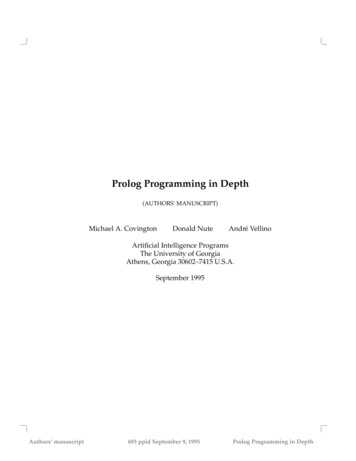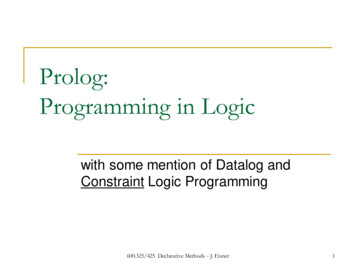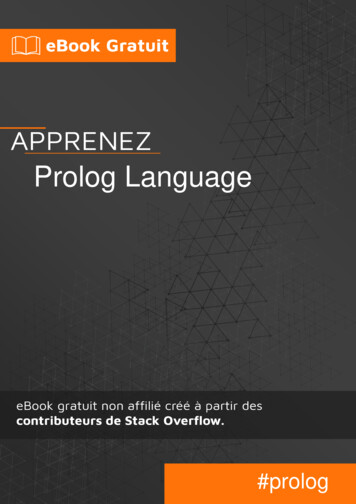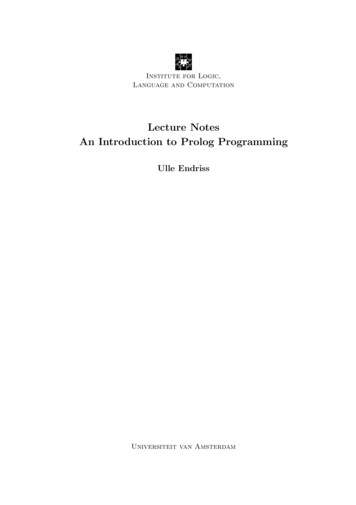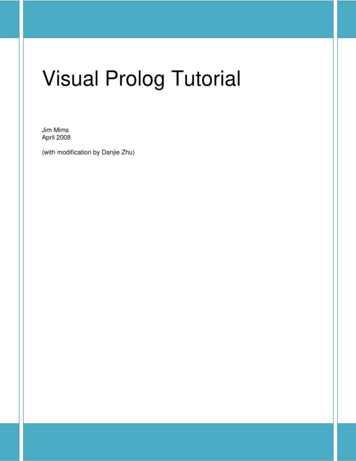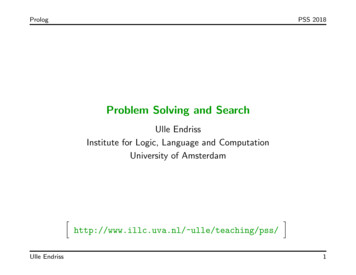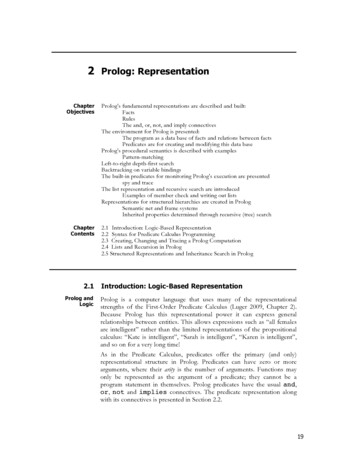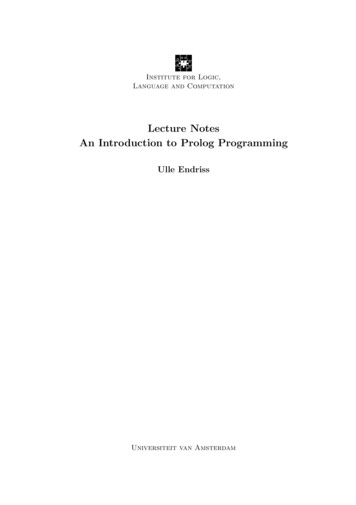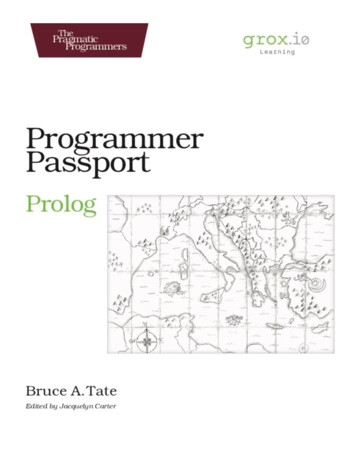
Transcription
PrologBruce TateThe Pragmatic BookshelfRaleigh, North Carolina
Many of the designations used by manufacturers and sellers to distinguish their productsare claimed as trademarks. Where those designations appear in this book, and The PragmaticProgrammers, LLC was aware of a trademark claim, the designations have been printed ininitial capital letters or in all capitals. The Pragmatic Starter Kit, The Pragmatic Programmer,Pragmatic Programming, Pragmatic Bookshelf, PragProg and the linking g device are trademarks of The Pragmatic Programmers, LLC.Every precaution was taken in the preparation of this book. However, the publisher assumesno responsibility for errors or omissions, or for damages that may result from the use ofinformation (including program listings) contained herein.Our Pragmatic books, screencasts, and audio books can help you and your team createbetter software and have more fun. Visit us at https://pragprog.com.For sales, volume licensing, and support, please contact support@pragprog.com.For international rights, please contact rights@pragprog.com.Copyright 2019 The Pragmatic Programmers, LLC.All rights reserved. No part of this publication may be reproduced, stored in a retrieval system,or transmitted, in any form, or by any means, electronic, mechanical, photocopying, recording,or otherwise, without the prior consent of the publisher.ISBN-13: pendingEncoded using the finest acid-free high-entropy binary digits.Book version: B1.0—Monthname, yyyy
ContentsChange History.v.124710121.Logic Programming BasicsWhat is Prolog, Anyway?The SWI Prolog ConsoleInferencesLayering InferencesTry It Yourself2.Logic Problem Solving .Map ColoringUnification, Lists, and Pattern MatchingEight QueensTry It Yourself.15151925333.Graphs .Directed Graphs With Edges as FactsBi-Directional GraphsOptimizing Paths and Weighted PathsTry It Yourself.35364144504.Schedules and Code OrganizationSchedule Teams on a FieldSchedule PossibilitiesEstablish ConstraintsWrite a Pretty SolutionTry It Yourself.535456596365.
Change HistoryThe book you’re reading is in beta. This means that we update it frequently.Here is the list of the major changes that have been made at each beta releaseof the book, with the most recent change first.B4.0: Mar 1, 2020 This is the last Prolog chapter, the second language in our Joe Armstrongtribute and celebration. This chapter is focused on practical Prolog,namely writing schedulers. Finish strong!B3.0: Feb 17, 2020 Welcome to the third Prolog chapter, the second language in our JoeArmstrong tribute and celebration. We’ll focus on solving problems withgraphs. Graph theory is becoming increasingly important in computerscience, and you’re about to find out why. Have fun!B2.0: Feb 3, 2020 Welcome to the second Prolog chapter, the second language in our JoeArmstrong tribute and celebration. We’ll solve the eight queens problemand the map coloring problem. If you’re on the Programmer Passport site,you can also find the video for solving a Sudoku puzzle. Have fun!B1.0: January 15, 2020 Welcome to the first Prolog chapter. Prolog is the first language in our JoeArmstrong tribute and celebration. Prolog was one of his favorite languages, and was used to make the first compiler for the Erlang language.report erratum discuss
CHAPTER 1Logic Programming BasicsThe next three releases in the Programmer Passport are part of our tributeto Joe Armstrong, one of the creators of Erlang. We’re going to focus on languages that inspired Joe and a few other technologies that Joe inspired,starting with Prolog. Many developers may not know that the earliest implementations of Erlang were written in Prolog. Eventually, Erlang was movedfrom Prolog to C, but you can still see a heavy Prolog influence.Prolog is at once fascinating and maddening because it’s so different frommany of the other languages you might have experienced. Instead of givingProlog a rote program describing exactly what to do, you’ll give it a databaseof facts such as “Bruce follows José”. Then, you’ll add some basic inferencesto your database such as “A user receives a tweet if that user follows someone,and that person tweets something.” Once you have that database, you canask Prolog questions, called queries, such as “Who receives tweets from José?”Prolog will tie the facts and inferences together to solve some prettydemanding questions.In this chapter, we’ll start with what makes Prolog different from other languages. Then, we’ll move into the Prolog environment and the basics of logicprogramming. Finally, we’ll look at making inferences with Prolog before weconclude.As you work through this module, look for ways that Prolog can help youthink about problem solving. Many programming languages can benefit fromthe way Prolog establishes rules and inferences. Some programming languageseven have implementations built in, especially Lisp dialects like Clojure. Keepyour eyes open and you’re sure to find something that you find interesting.Let’s get started!report erratum discuss
Chapter 1. Logic Programming Basics 2What is Prolog, Anyway?As we start each language, the first thing we strive to do together is understanda language’s reason for being. So far, the languages we’ve covered have bothbeen general purpose languages. Though they’re each built to play in a focusedniche, both Crystal and Pony are built to solve general purpose problemswithin their niche. Java, Ruby, and Python are examples of mainstreamgeneral purpose languages. Lisp, Erlang, and Haskell are examples of mainstream languages that establish a niche among general purpose languages.Other languages exist to solve problems in a specific genre. For example, SQLis built to retrieve data from databases and HTML is built to provide structureto documents, particularly web pages. Like these languages, Prolog is aproblem-specific language built to handle logic programming. As such, it’san important language for artificial intelligence.Since Prolog is not a general purpose language, its goals and strategies forprocessing programs vary significantly from other languages. Let’s look atsome of the features that define it.Prolog is a language that relies on databases. Each databases uses data inthe form of facts and rules. Facts are specific axioms about a problem set,and rules express generalizations. Then, Prolog ties the data in the databasetogether to make more sophisticated inferences. These factors make Prologa good language for problems that involve logic, especially when a programmust establish a series of facts to get to a more sophisticated inference.Important Prolog FeaturesProlog made at least three huge contributions to programming languages:unification, backtracking, and inference programming. Let’s form a roughdefinition of each, and then we’ll tighten them up as we go.unificationMost languages you’re used to probably work on one side of an expression,like an assignment, at a time. With Prolog’s unification, a program cansolve for variables on both sides of a single expression. We’ll look at manyunification problems through the course of these four chapters.backtrackingThe next major contribution is backtracking. When Prolog is working ona problem, it doesn’t look for a single solution to a problem. It looks forall of them. When Prolog is solving a complex query, sometimes it looksreport erratum discuss
What is Prolog, Anyway? 3for all possible partial solutions. When one partial solution is wrong,Prolog can backtrack and try another.inferencesProlog is able to combine multiple rules in a database to build its owninferences. These can happen recursively, and these inferences can bequite complex. For example, when we solve a map coloring problem, we’lltell Prolog that colors come from a list, that certain countries share borders, and that our map must not put similar colors together. Prolog willinfer valid colorings!These different features make Prolog a good choice for some artificial intelligence problems. Before we install Prolog, let’s look into some of the basics.Prolog Programming BasicsAt its core, Prolog programs have three parts: facts, rules, and queries. A factis a piece of information about the world. In this section, we’ll look at simplefacts made up of predicates and atoms. Here are some examples of facts, andtheir potential meanings.factmeaningred(car).The car is redfast(car).The car is fastfun(car).The car is funowns(car, jim).jim owns carblue(prius).The prius is blueIn these facts, the atoms are car, jim. and prius, the words inside the parentheses. Each of these expressions is a predicate.Our predicates can get more sophisticated. Our logic gets more interestingonce we use variables within logical rules, and let Prolog fill out those variables. A variable starts with an uppercase letter. Eventually variables willhold values, such as the car and jim atoms. We can specify rules. A rule specifies a type of if-then condition. Here are some examples.rulemeaningred(Thing) :- fun(Thing).If a thing is red, it’s funfast(Thing) :- fun(Thing).If a thing is fast, it’s funThe above rules will let Prolog infer that a red car is fun, but a blue prius is notfun.report erratum discuss
Chapter 1. Logic Programming Basics 4With the basics out of the way, let’s install Prolog and write some code!The SWI Prolog ConsoleBefore we can solve problems in Prolog, we’ll need to install the Prolog consoleand learn to navigate it. We’ll be working with SWI Prolog. This implementationwas built by Jan Wielemaker. SWI comes from the name of a University ofAmsterdam group Sociaal-Wetenschappelijke Informatica. The Englishtranslation is “Social Science Informatics.”This open source Prolog implementation has binaries that run on Windows,OS X, and several Unix dialects. It’s one of the most broadly used Prologimplementations today. Follow the installation instructions.1After working with a couple of languages that don’t have first class consoles,you may be pleased to learn that we’ll be doing much of our work in consolesthat allow us to load and manipulate data directly. Before we create adatabase, let’s issue a few commands to get a sense for how the console works.Each command we type is a query, one that returns either true or false, andProlog will do its best to answer that query. If our query has variables, Prologwill do its best to fill in the values that make the query true.Once you’ve installed, bring it up by typing swipl (on most environments), andthen type this query:?- write("hello, world").Notice we terminated the statement with . and that’s important. It tells Prologthat the query is done, and it’s time to start computing.Prolog responds with:hello, worldtrue.Each query has a value of true or false. A predicate is part of a query. The writepredicate is always true, and it prints a value to the console. The second lineis the value of the query we just entered, true.If you want to join two statements together with and, type a comma betweenthem, like this:?- write("hello, world"), write(" and that's a wrap.").hello, world and that's a tures/lsp/010 install swi prolog.htmlreport erratum discuss
Prolog will tie the facts and inferences together to solve some pretty demanding questions. In this chapter, we'll start with what makes Prolog different from other lan-guages. Then, we'll move into the Prolog environment and the basics of logic programming. Finally, we'll look at making inferences with Prolog before we conclude.
